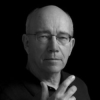Sam Abell

Sam Abell
Sam Abellis an American photographer known for his frequent publication of photographs in National Geographic. He first worked for National Geographic in 1967, and is one of the more overtly artistic photographers among his magazine peers. Sam Abell's style of photography is documentary in the sense that his major avenue, the National Geographic magazine, is a publication of record. However, his best work is known for its transcendent qualities, starting at the documentary level yet open to interpretation on an...
NationalityAmerican
ProfessionPhotographer
CountryUnited States of America
In the last workshop I taught, a woman flew in from Thailand. She's a medical doctor in Bangkok. I asked her in her one-on-one session where she wanted photography to be in her life.Did she want a second career? Was it about earning money? Or was it art? And she said "None of those. I want photography to be serious in my life." It would be like someone wanting music, like piano playing, to be a richer, deeper, and maybe even harder experience.
When assignments were over, photography continued. One of the primary reasons it did was that I wanted and needed to have fresh work. Also, it's very stimulating to be around non-professional photographers. They're the ones with the purest flame burning about their photography. I appreciate that.
I was asked by a student what my most significant accomplishment was at National Geographic, after thirty years, and I said that my career came to an appropriate close, and I still loved photography. Not everybody who spends their career at anything ends up fascinated and involved with it.
I think that it's workshops, honestly, that have kept me keen about photography, and about my photography. My career as a workshop photographer came while I was at the Geographic in the late 70's, and has continued consistently since then.
This might seem off the track, but an interesting thing to me that others could talk about better than I, but one of the growth areas in photographic education has been the so-called slow photography.
The thing with my workshops is, photography is a thoughtful process. In an atmosphere of fast photography, and generally thoughtless, quick, automatic photography, I think that there is an interest in the slowed down, thoughtful approach.
I did it once, and National Geographic recruited me. I did it primarily out of curiosity. A lot of legendary photographers had worked on that campaign. Ernst Haas had done the early photography, and I knew him. There's a lore in photography about that campaign, and I was curious.
I had luck, but I worked hard and I suffered. It's not just photography I'm talking about. It's about whatever dream you want it to be.
My father taught me photography. It was his hobby, and we had a small darkroom in the fruit cellar of our basement. It was the kind of makeshift darkroom that was only dark at night.
For spiritual companions I have had the many artists who have relied on nature to help shape their imagination. And their most elaborate equipment was a deep reverence for the world through which they passed. Photographers share something with these artists. We seek only to see and to describe with our own voices, and, though we are seldom heard as soloists, we cannot photograph the world in any other way.
One of the things that I most believe in is the compose and wait philosophy of photography. It’s a very satisfying, almost spiritual way to photograph. Life isn't’ knocking you around, life isn't controlling you. You have picked your place, you’ve picked your scene, you’ve picked your light, you’ve done all the decision making and you are waiting for the moment to come to you.
As I have practiced it, photography produces pleasure by simplicity. I see something special and show it to the camera. A picture is produced. The moment is held until someone sees it. Then it is theirs.
Editorial photography has to be energetic and visually competitive.
And that desire-the strong desire to take pictures-is important. It borders on a need, based on a habit: the habit of seeing. Whether working or not, photographers are looking, seeing, and thinking about what they see, a habit that is both a pleasure and a problem, for we seldom capture in a single photograph the full expression of what we see and feel. It is the hope that we might express ourselves fully-and the evidence that other photographers have done so-that keep us taking pictures.